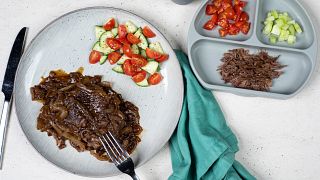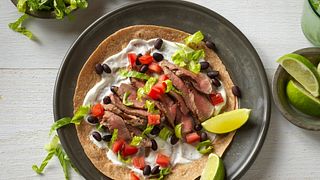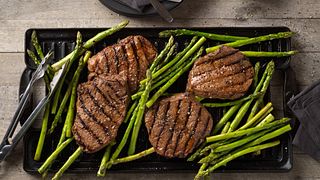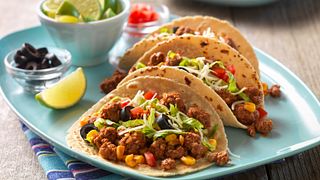6 Reasons to Feed Beef to Your Baby
by: Keith Ayoob, Edd, rd, fand
Nutrition science constantly evolves, and the past several years have seen dramatic changes in nutrition and feeding recommendations for infants and toddlers. The 2020-2025 US Dietary Guidelines for Americans are the first to issue specific dietary recommendations for ages birth to 24 months.1 And even though less than 10% of infants eat beef in their first 12 months of life, these updated guidelines are encouraging parents to introduce nutrient-dense foods, like beef, to make every bite count in these early years.1, 4, 13, 16
Let’s explore the “whys” and “hows” to introducing beef to your infant or toddler and share a few surprising reasons why beef can be a great early food option for your growing infant.
6 Things You Didn’t Know About Beef
1. Historically, meat, including beef, was a first food!
Many cultures around the world fed infants meat, including beef, until commercial baby food was invented, in the late 19th century. Before that, everyone made their own baby food by finely mincing or grinding the same food they fed their families. Infant cereal is relatively new.
2. The iron in beef is better absorbed than iron in fortified baby cereals2,3
Iron is essential for growth and development, but the source and type of iron impact the amount of iron that the body can use and absorb.
- Beef is one of the best sources of heme iron, the kind of iron the body absorbs more easily than the non-heme iron found in plant foods.4,5,6 Fortified infant cereal has more total iron, but the heme iron in beef is absorbed nearly 6 times better.
- Beef stands out among other animal-sourced foods! The most eaten alternatives to beef are egg, chicken, ham. These proteins are poorer sources of iron than beef. Beef has up to twice the iron these other foods. Choosing these foods often may have implications for the iron status of young children.7
"It’s clear: Alternatives to beef are NOT beef equivalents! Beef is unique as a complementary food for infants."
3. Beef is about more than iron!
Beef has a whole package of 10 essential nutrients, including:
- Protein: essential for physical growth and development2
- Heme iron: critical for neurologic development and proper immune function
- Zinc: active in cognitive growth and development, strengthening communications between neurons in the brain, and immune function8,9,10
- Choline: essential in every part of the body and supports proper brain development, memory, regulating heartbeat, among other functions
- Vitamin B12: naturally found only in animal foods, B12 supports brain and nervous system development and healthy blood cells formation12
- Vitamin B6: supports normal brain development and function13
4. A plate for a healthy gut includes plants -- and beef!
“Plant-based diets” don’t mean eating only plant foods. Some parents may eat a vegetarian or vegan diet and feel their baby should eat a similar diet. However, babies are NOT little adults! Infancy and toddlerhood are the most rapid periods of growth and development, demanding proportionally more protein, nutrients, and even fat than adults do. Their smaller stomachs need to get all this nutrition in smaller bites and serving sizes. Nutrient-dense foods like beef, with 10 essential nutrients, can help meet these needs.
Beef and plants pair well on the plate and it’s important to expose infants and toddlers to a variety of nutrient dense foods like fruits, vegetables, grains, nuts, seeds, and dairy, as well as meat, eggs, and fish.
5. A balanced diet featuring beef supports healthy digestion
For a food to be healthy, your baby’s tummy must tolerate it. A balanced digestive tract has a diversity of healthful (“good”) bacteria, supplied by a variety of healthful foods. Plants and grains are important, and iron plays a role, too. Feeding your baby foods that contain iron can help boost the diversity and amount of healthy gut bacteria, but the form of that iron may also have an influence on growing healthful gut bacteria.11
In a study comparing babies given either iron-fortified cereal or beef:
- Babies fed iron-fortified cereal had greater declines in the number and species of healthful bacteria
- Babies fed meat (beef was the meat used in the study), with its natural heme iron had greater abundance and diversity of healthful gut bacteria.11
6. Beef goes beyond nutritional benefits
Every bite of beef delivers new flavors and textures to help support growing infants’ oral and motor development, learning and discovery, and acceptance of new, healthy foods and textures.1,2 Researchers call the period from the first introduction of complementary foods, through 24 months of life, the “flavor window,” a time when infants and toddlers are very open and accepting of new tastes. Around 6 months is an excellent time to prime the palate and introduce children to new flavors, especially for bitter tasting vegetables – the one food kids usually have the hardest time accepting. Science also says pairing these foods with beef (like beef and broccoli) can help make them more acceptable to babies.
Teaching children to enjoy these flavors at an early age can set them up for healthy eating habits for life. Infants and toddlers often refuse new foods at first. That’s normal! It can take up to 12-15 different introductions for babies to come around to liking a new food, so just be patient – and stay the course!
For all the above reasons, and more, beef has unique advantages as one of your baby’s first foods. However, despite these reasons, beef has not always been the most popular choice as a first food. So, why are we starting to see a shift back to beef?

Where Was The Beef?
For decades, rice cereal was the first food recommended when transitioning your baby from breast milk or formula. Here’s why:
- It’s fortified with iron and babies need iron from food to support rapid growth and development. Around 6 months of age, babies’ iron needs are increased and can no longer be met through breastfeeding alone. More than 3 in 4 exclusively breastfed infants (77%) don’t get enough iron between 6-12 months of age. Increasing evidence points to iron-deficiency potential impact on neurodevelopment, cognitive scores, and behavior, even after the deficiency is corrected.1,14,15
- It’s hypoallergenic and tolerated by nearly all infants.
- The flavor profile is bland, no shock to developing taste buds. This contrasts with current recommendations in the 2020-2025 US Dietary Guidelines (pg 71,72) that infants be introduced to a variety of foods, even potentially allergenic foods, when complementary feeding begins. Early and repeated exposure to a variety of nutritious foods increases the likelihood that infants will accept new foods.16
Typically, rice cereal was followed by other cereals, then pureed fruits and vegetables. Meats, like beef, were often not recommended until 8 months of age, with the introduction of finger foods.
However, there’s no scientific evidence for delaying the introduction of meat, particularly beef. Rice cereal doesn’t have to be the first food! In fact, we know that there are some real advantages to adding beef to your child’s diet.
Now, you may be wondering why there is so much focus on iron in these first two years of life. Well, that’s because iron, whether it comes from rice cereal or beef, is an essential part of an infant’s growth and development. And it turns out, many infants aren’t getting enough.
Why Focus on Iron?
Increasing evidence points to iron-deficiency’s potential impact on neurodevelopment, cognitive scores, and behavior, even after the deficiency is corrected.17,18
According to, the landmark Nestle Feeding Infants and Toddlers Study (FITS), the largest dietary intake study of infants and toddlers ever done, covering 2002-2016:19
- Iron intake by infants and toddlers in the US declined, as did consumption of iron-rich foods, including beef and fortified cereals.
- Iron-deficient diets in infants and toddlers doubled during this period.
Breastfeeding increased during these years, and that’s good, but it doesn’t protect against iron-deficiency anemia. The 2020-2025 US Dietary Guidelines for Americans, noted that, more than 3 in 4 exclusively breastfed infants (77%), did not get enough iron during the period from 6-12 months of age.
This is why introducing beef in these early years can offer some unique advantages to infants during this demanding stage of growth and development. Keep reading for some tips on how you can introduce beef to your infant as they grow into toddlerhood!

Tips for Introducing Beef as an Early Food
- Puree Leads the Way! Between 6-8 months, your baby may be ready to start on first foods that have a pureed texture. Commercial baby foods often call these “strained” foods, and they are a convenient option. However, making your own puree is simple, easy, and can be more budget-friendly. Puree beef with a little breastmilk or formula to develop a thin consistent taste and texture.
- Baby food needs baby steps! Combine new foods with baby’s favorite flavors. Mix mashed sweet potato with beef or pureed spinach with applesauce.
- Start small. Put just a “pea-sized” dab onto the center of the spoon, then add a familiar food on top.
- Babies may resist, so parents must persist! It’s normal for a baby to spit out a new food. After a few tries, parents may think the baby just doesn’t like the new food. Not true! Babies just take more time to make up their minds -- remember that introducing new foods to baby is an educational experience for them as they are learning and discovering new tastes and textures. One study found that babies needed 7 or 8 different occasions of being offered a food before they learned to like it. Once they did, it was smooth sailing. So, play the long game when introducing beef, or any new and healthful food!
- Read labels: Jars of “beef dinners” (which often include strained dumplings vegetables and beef) may have very little beef – or iron or protein! Compare the iron, protein, and zinc content of a serving of this “beef dinner” with a serving of simple strained beef:
"Beef Dinner"+(1 Serving: 4-oz.) |
Strained Beef++(1 Serving: 2.5-oz.) |
|
|---|---|---|
| Protein | 8% Daily Value (DV) | 50% DV |
| Iron | 4% DV | 8% DV |
| Zinc | 10% DV | 50% DV |
*Because a jarred ‘beef dinner’ has ingredients aside from just beef, the portion size is typically larger. A daily serving of meat for infants is 2 oz. + https://www.gerber.com/2nd-foods-vegetable-beef-dinner-baby-food ++ https://www.gerber.com/beef-and-gravy
Jarred baby foods can be a convenient option, but nothing beats the real thing! Whole beef, whether it’s pureed, sliced, shredded, or chopped, can provide more variety in texture and flavor. Plus, it’s closer to what the rest of the family is eating for dinner.
“Pro-Tips” for Beef at Any Age:
By 8-12 months, babies are usually comfortable with pureed foods. Some hints that they’re ready for more challenging textures:
- Grasping food with their hands
- Showing curiosity about what you’re eating
- Bringing a spoon to their mouths
At this point, foods still need to be soft and moist. Here are ways to offer the nutrition of beef beyond pureed textures:
- Meat loaf and meat balls! Ground Beef is moist and easy to mash. Mixing in some egg and breadcrumbs make them even softer. Slow cooking not only adds flavor, it softens beef so it’s easily shredded for the 10-12-month-olds and toddlers to pick up with their hands.
- Get creative! Beef isn’t sweet, but it’s great to mix into pureed fruits and veggies!
- Puree beef with avocados, for a guac-beef mash-up!
- Use pureed beef as a thickener: Mixing strained beef into other foods like soups, stews and purees can help maintain a thicker texture that allows baby’s developing skills more control during feeding.

The Goal: Family Mealtimes
Feeding your baby and toddler family favorites is a joy for every parent. Food is more than its nutrients, it’s a way for families to connect, comfort and celebrate. Being at the table together also helps babies and toddlers learn about food and develop socially and emotionally. There’s a reason “the party always ends up in the kitchen!”
Babies and toddlers love flavor! This can surprise parents, but when you cook for your baby, it’s OK to add the seasonings, herbs and spices your family likes! Just be sure to hold off on the salt or sugar when serving infants and toddlers.
True story: I was evaluating a toddler patient who was underweight and not eating well. His parents gave the caregiver jarred baby foods to give the baby while they were at work. The caregiver told me, “When I give him food I cook myself, he eats really well. Is that OK? I think he likes how I season my food, so he eats more.” She fed the toddler beef and other meats, potatoes, rice, beans, and vegetables, minced and mashed forms of the same foods she’d eat herself.
What you should take-away:
- Beef is unique as a first food, with 10 essential nutrients, including well-absorbed iron.
- Beef is easy and safe to introduce once baby is ready to begin solid foods -- typically around 6 months of age.
- Including beef in a plant-based lifestyle helps build the foundation for a diverse and nutrient-dense diet for growing infants and toddlers.
- The benefits of beef go beyond nutrition – new tastes and textures are important for your child as they learn how to eat a healthy and balanced diet.
- The science is clear and global health authorities agree: beef offers unique nutritional advantages as a first food and for complementary feeding of infants and toddlers.
Subscribe to our newsletter so you don't miss the best recipes, cooking tips, and more.
Privacy Policy- U.S. Department of Agriculture and U.S. Department of Health and Human Services, Dietary Guidelines for Americans, 2020-2025. 2020. p. 71-72
- Hambridge et al. Evaluation of meat as a first complementary food for breastfed infants: impact on iron intake. Nutr Rev. 2011 Nov;69 Suppl 1(0 1):S57-63
- Lombardi-Boccia, G., B. Martinez-Dominguez, and A. Aguzzi, Total Heme and Non-heme Iron in Raw and Cooked Meats. Journal of Food Science, 2002. 67(5): p. 1738-1741.
- Schwarzenberg, S.J., M.K. Georgieff, and Committee on Nutrition, Advocacy for improving nutrition in the first 1000 days to support childhood development and adult health. Pediatrics, 2018. 141(2).
- Prado, E.L. and K.G. Dewey, Nutrition and brain development in early life. Nutr Rev, 2014. 72(4): p. 267-84.
- Baker, R.D., F.R. Greer, and P. Committee on Nutrition American Academy of, Diagnosis and prevention of iron deficiency and iron-deficiency anemia in infants and young children (0-3 years of age). Pediatrics, 2010. 126(5): p. 1040-50.
- U.S. Department of Agriculture, Agricultural Research Service. FoodData Central, 2019. fdc.nal.usda.gov. (NDB for beef #13364, NDB for egg #01332, NDB for chicken breast #05064, NDB for pork #10093)
- Sandstead, H.H., Subclinical zinc deficiency impairs human brain function. J Trace Elem Med Biol, 2012. 26(2-3): p. 70-3.
- Sensi, S.L., et al., Zinc in the physiology and pathology of the CNS. Nat Rev Neurosci, 2009. 10(11): p. 780-91.
- Wessels, I., M. Maywald, and L. Rink, Zinc as a Gatekeeper of Immune Function. Nutrients, 2017. 9(12).
- Krebs NF, Sherlock LG, Westcott J, Culbertson D, Hambidge KM, Feazel LM, Robertson CE, Frank DN. Effects of different complementary feeding regimens on iron status and enteric microbiota in breastfed infants. J Pediatr . 2013 Aug;163(2):416-23.
- National Institutes of Health Office of Dietary Supplements, B12: Fact sheet for health professionals. Available at https://ods.od.nih.gov/factsheets/VitaminB12-HealthProfessional/.
- National Institutes of Health Office of Dietary Supplements, B6: Fact sheet for health professionals. Available at https://ods.od.nih.gov/factsheets/VitaminB6-HealthProfessional/.
- American Academy of Pediatrics Committee on Nutrition, Pediatric Nutrition, 8th Ed, ed. Kleinman RE & Greer FR. 2019, Itasca, IL: American Academy of Pediatrics. 1688.
- Hernell, O., et al., Summary of Current Recommendations on Iron Provision and Monitoring of Iron Status for Breastfed and Formula-Fed Infants in Resource-Rich and Resource-Constrained Countries. J Pediatr, 2015. 167(4 Suppl): p. S40-7.
- Spill MK, Johns K, Callahan EH, Shapiro MJ, Wong YP, Benjamin-Neelon SE, Birch L, Black MM, Cook JT, Faith MS, Mennella JA, Casavale KO. Repeated exposure to food and food acceptability in infants and toddlers: a systematic review. Am J Clin Nutr. 2019 Mar 1;109(Suppl_7):978S-989S. doi: 10.1093/ajcn/nqy308. PMID: 30982874.
- Betsy Lozoff, John Beard, James Connor, Barbara Felt, Michael Georgieff, Timothy Schallert, Long-Lasting Neural and Behavioral Effects of Iron Deficiency in Infancy, Nutrition Reviews, Volume 64, Issue suppl_2, May 2006, Pages S34–S43, https://doi.org/10.1111/j.1753-4887.2006.tb00243.x
- Lozoff B, Jimenez E, Smith JB. Double Burden of Iron Deficiency in Infancy and Low Socioeconomic Status: A Longitudinal Analysis of Cognitive Test Scores to Age 19 Years. Arch Pediatr Adolesc Med. 2006;160(11):1108–1113. doi:10.1001/archpedi.160.11.1108
- Roess, A.A., Jacquier, E.F., Catellier, D.J., Carvalho, R, Lutes, A.C., Anater, A.S., and Dietz, W.H. Food Consumption Patterns of Infants and Toddlers: Findings from the Feeding Infants and Toddlers Study (FITS) 2016. J Nutr. 2018 Sep 1;148(suppl_3):1525S-1535S. doi: 10.1093/jn/nxy171
- Maier et al. (2007). Effects of repeated exposure on acceptance of initially disliked vegetables in 7-month old infants. Food Quality and Preference. 18. 1023-1032. 10.1016/j.foodqual.2007.04.005.






